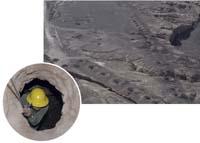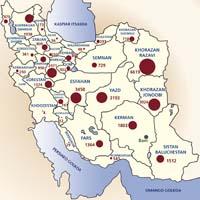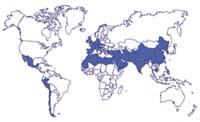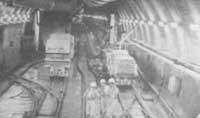Text written in Basque and translated automatically by
Elia without any subsequent editing.
SEE ORIGINAL
Channel incidents Bam
2008/10/01
Salih, Abdin1 | Salamat, Alireza2
Iturria:
Elhuyar aldizkaria
Island is located in an arid and semi-arid area. It only rains 252 mm a year, that is, a third of the world average. Approximately 90% of the country suffers from water shortages. For centuries, Iranians have learned to combat it. They have learned different techniques to use this little water for houses and irrigation. Among these techniques, the qanat system is one of the most efficient, invented in Bam thousands of years ago. The area of Bam, southeast of Iran, is a desert with a large dependence of qanatas. Since an earthquake destroyed the city four years ago, Tehran's UNESCO office has been strengthening Iran's efforts to rebuild Bam's qanatas and ensure its best conservation in the future.
Channel incidents Bam
01/10/2008 | Salih, Abdin 1 ; Salamat, Alireza 2 | 1 Former director of UNESCO's Tehran office (until September 2007). 2 Expert of the Territorial Water Management Center of the City of Tehran, a centre dependent on UNESCO.

Anyone who approaches the plain of Iran will find these lines of wells crossing an arid landscape that look like clothes stitches. It is the wells of Qanateta, visible part of the underground channels, which transport water from the main well, usually located in the mountain area, from a sloping tunnel, to the place where it will be used.
©ICQHS-Yazd
The qanatas are water supply systems, with an underground tunnel attached to the surface by several wells. They have been made in zones without surface waters. Most of the water courses are underground, so that the qanatas reduce water losses due to infiltration and evaporation. Gravity force is used to drive water downstream of the channel, thus avoiding the use of pumps.
Qanats have a special place in the cultural, socio-economic, political and physical landscape of Iran. Although for centuries life has changed radically, qanatas are still important for the well-being of the community and are necessary for survival in many parts of the country. However, in recent years, there has been a decline in the number of experts who know how to use these systems.
Canals of Bam, victims of the earthquake
The area of Bam is the typical desert oasis, with an average annual rainfall of about 60 mm. In recent years, in addition, it has rained less than normal. Approximately 70% of the population of Bam and neighboring municipalities is directly or indirectly related to agriculture and is predominantly dominated by qanats. Until December 26, 2003, a class 6.5 earthquake destroyed the old city, the Qanatas provided 50% of the water it needed annually.
With most of the 90,000 inhabitants of the city in bed, the earthquake occurred at 05:28 in the morning, with the death of a third of the population and most of the survivors lost the house. More than 80% of the city's buildings were demolished by the disaster. Among them were other old buildings, such as the citadel and historical hydraulic structures called cultural heritage, the qanatas. The earthquake caused blockades in many qanats of Bam and many others fell. In some cases, the earthquake caused the water to infiltrate other qanats, thus increasing the flow of water.

Qanatas are water supply systems through tunnels and underground wells.
©ICQHS-Yazd
Fortuitous archaeological discovery
In studies carried out shortly after the earthquake, archaeological remains of thousands of hectares appeared. It did not cause earthquakes to appear, they were on the ground, dispersed and abandoned for years. The archaeological research that is being carried out in this area has shown that this area is more important than was thought when preparing the report for the inclusion of Bam in the UNESCO World Heritage Centre. The oldest in Iran, and perhaps the world qana, appear to be in the Bam area.
It seems that the advantages of the natural location of Bam, located on a plain between two mountain ranges that receive rain and snow, have made this city so important in the invention and development of qanatas. The geographical situation of Bamen was optimal for the construction of shallow wells and qanat systems. In addition to being the oldest in Iran's Qana, the area has the highest qanat density, with about 375 lines of old traditional qanats and about 950 wells of different depths divided into several sections.
Bam's qanata systems reached their peak in the early Islamic era and lost strength in the XII. At the end of the twentieth century by the wars. Although the war somehow affected, the qanat system lasted, although the city never recovered its previous fame. However, being a landscaped city of a semicircular zone, the fascination generated by Bam has not diminished.

Traditional qanat system. The main well (or the mother) is usually done in the mountain, submerging it deeply into the freatic surface. The main well water falls through a tunnel with little inclination. The volume of water increases progressively until it leaves abroad near farms or communities. The water is carried to the soil enriched by alluvial cones. The cultivated land and the places of residence of the people are located below the point of departure of the water to the surface. People take water at the nearest point, Mazharea. It is usually located in the town square. The slope is, in general, well preserved and with a rigorous supervision of the use of water. A tunnel or payab carries water from the residential area to the planted area.
Farmers trying to rehabilitate qanatas
The development of the social structure of the area of Bam has been the subject of a great help from qanat. The construction of qanats is a hard and expensive work that has always been a collective action, with multiple beneficiaries and shared property. Access to qanatas water and water management is regulated by the team responsible for the use of water. The members of the responsible team are also water owners, many of them farmers.
The earthquake caused the poverty of these peasants, which made it even more difficult to rehabilitate the Qanatas. Meanwhile, prices skyrocketed due to the lack of skilled labor and material.
Intervention by UNESCO
After the earthquake, Iran tried to rebuild the qanatas that were damaged or totally destroyed, and the UNESCO office in Tehran offered its help. Its aim was to ensure greater protection and future management of qanatas. Six expert groups were asked to prepare detailed technical reports on Qanat's current situation and future prospects. These pages highlight some of his tips.

The old city of Bam, before and after the earthquake of 2003.
© UNESCO
In the first phase of the project, in 2004, each group analyzed an aspect of the problem: The International Center of Qanats and Historical Hydraulic Structures analyzed from the engineering point of view the Bam qanatas, the Ministry of Agriculture and Agriculture from the agricultural point of view, the Iranian Organization of Cultural Heritage and Tourism from the cultural point of view, two experts of the UNESCO from the archeological point of view, the Office of Geology of Iran

Qanatas of Iran. It is estimated that there are 32.160 active systems throughout the country. The total flow rate is 9 billion m 3.
Qanat International Centre
Each participant made a report for their presentation at the workshop organized by UNESCO's Tehran office in the Bam qanatas in June 2005. In the second half of 2005 the reports were gathered and sent to the Iranian government. Then, the Ministry of Agriculture and Jihad presented the second part of the project: reconstruction and rehabilitation of qanatas. This process is still underway.
Since June 2005, the Tehran office of UNESCO, in collaboration with the International Centre for Qanats and Historical Hydraulic Structures of Yazd, which works under the auspices of UNESCO, has taught two training courses in qanats. Bamen was the first course and the second in Yazde in July 2007. A greater number of training courses are expected in this area.
The Ministry of Higher Education also collaborates with the training center on qanatas created in 2003 to ensure the correct management of qanatas in the long term. The centre is located in the city of Taft, near Yazd. Its qanatas are also well known. Students study geology and hydrogeology, history, archaeology, classification of qanats, traditional methods of construction and maintenance of qanats, operation of qanats, distribution of water and socioeconomic aspects.

One month after the earthquake, 30,000 people survived in areas similar to the image store and other emergency shelters. For the year 2007 they were replaced by definitive houses with steel structure, while in rural areas 25,000 homes were built. About 98% of the population is moved from home.
©ICQHS-Yazd
On the other hand, it intends to extend the project to other countries of the group that assumes the Tehran office of UNESCO, which are the only way to supply water in many places. One of them is Afghanistan. He has prepared a report, in collaboration with UNESCO, on the project being carried out to complete the country's qanatas inventory.
The disaster of the Bam earthquake revealed the sophisticated culture of rational distribution of resources, which for many years had been abandoned. This ancient way of managing underground water was seen by everyone. It perfectly explains the human capacity to cope with water shortages, a capacity that before, now and always has great importance for arid and semi-arid areas.
Additional information:
Information on the international centre of qanats and historical hydraulic structures: www.qanat.info/en/index.php
Source: UNESCO. "The fall and rise of Bam's qanats", A World of Science, 6. vol. Nº 1, January - March 2008 (http://www.unesco.org/science/). Article translated and adapted by Elhuyar with the authorization of UNESCO.
Brief history of Qanat
It is believed that the original territory of Qanat is Iran, as some of its qanats are about two thousand years old. In the historical expansion of the Persian empire, they gave water to the entire territory.
For Henry Gubler, the western calendar BC. The personnel of the coal mines made the first channels around the year 800 to remove water from the mines. Little by little the farmers began to use this technology and spread across the entire Iranian plain.
a.C. In the years 550-331, when the Persians dominated the territory of Indua to Nile, the qanats technology extended to the entire empire. In the West, Qanatas were built from Mesopotamia to the Mediterranean Sea. a.C. By 525 the technology reached Oman and Saudi Arabia through the Persians. a.C. Around 500 he arrived in Egypt.

Worldwide distribution of qanats (in blue).
(Photo: International Centre for Qanats and Historical Hydraulic Structures)
They were built in eastern Persia, in Afghanistan, in central Asia, in the so-called Silk Road and in China's Turkestan.
Roman and Byzantine period (BC) 64-d.C. 660), numerous qanats were built in Syria and Jordan. It seems that from there the technology spread to the north and to the west, to Europe. Remains of those who were the Qanatas of the Romans to Luxembourg have been found.
The Muslims took the Qanatas to Africa. d. d. C. C. Around the year 750, the Arabs built their first yafuga (qanata) in Madrid. Later, the Spaniards took them to Mexico, DC. About 1520. Subsequently, technology reached Los Angeles (USA) and Chile.
60% of the world's qanats are in Iran, from where it has spread to about 36 countries, such as: Afghanistan, Algeria, Bahrain, Cambodia, Chile, China, Cyprus, Czech Republic, Egypt, France, Germany, India, Iraq, Jordan, Libya, Mexico, Morocco, Oman, Pakistan, Peru, Qatar, Russia, United Kingdom, Sudan, Turican, Tourists, United States, Tourists, Tourists, United States
The earthquake destroyed 40% of Bam qanat
According to Iran's Office of Geology, Bam's fault has helped maintain underground water on the upper terrace, where the city of Bam is located. Create a kind of underground dam so that the water does not leave the aquifer.
According to the geological report, the 2003 earthquake did not move many failures and the underground situation in the territory is not believed to have changed much.

Employees in the repair of one of the Bam qanatas.
(Photo: ©ICQHS-Yazd)
The report indicates that the qanatas near the main break suffered greater damage than the others due to the direction of the seismic waves. According to a first assessment, 40% of qanats fell or suffered severe damage from the earthquake.
Earthquakes affect the linear structure of qanatas in two ways: by shaking or by loss of surface water. Vibrations are the vibration of the earth caused by seismic waves. It affects all underground structures in the form of a tunnel. The damage to the structure depends on the design, hardness, versatility and flexibility. The overall loss is due to different types of instability.
To reduce the risk of involvement to the structure, it is necessary to avoid areas with a tendency to earthquakes. However, qanatas are usually many kilometers and it is almost impossible to avoid this problem.
Tips to protect qanatas
UNESCO and its partners advise the Iranian government on:
· When rebuilding qanatas after an earthquake, take into account the faults found lately.
· Analyze the characteristics - both geotechnical and engineering - of areas close to qanatas.
· Make a map of ancient qanats that still provide water to avoid damaging more current structures and channels.
· Build as little as possible around qanat systems.
· Reinforcing the structure in the environment of the entrance wells and qanat galleries.
· Establish restrictions on the execution of deep wells to prevent excessive water extraction from decreasing the water surface and reducing the yield of qanatas.
· New wells will be made only when they are mandatory and must be made at a minimum distance of 3 km from existing qanatas.
· Document and preserve the traditional knowledge of Qanat users.
· Ensure the compatibility of traditional management and new management systems to meet the economic, social and technical needs of qanat user communities.
· Establish a complete network of surface water monitoring.
Salih, Abdin 1 ; Salamat, Alireza 2
Services Services Services
246 246
2008 2008 2008 2008 2008
Services Services Services
032 032 032 032
History of history History
Article Article Article
Description Description Description Description














